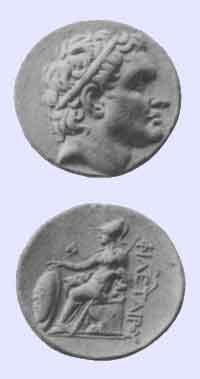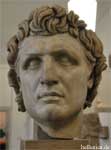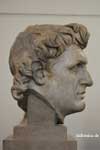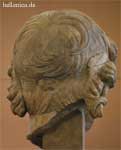- 1 Livy 33.21-22 (http://mcadams.posc.mu.edu/txt/ah/Livy/Livy33.html) says that Attalus died in the consulship of Cornelius and Minucius (197 BC) at the age of 72, having reigned 44 years. Polybius 18.41 (http://www.perseus.tufts.edu/cgi-bin/ptext?lookup=Plb.+18.41) also says that he lived 72 and reigned 44 years. Strabo 13.4.2 (http://www.perseus.tufts.edu/cgi-bin/ptext?lookup=Strab.+13.4.2) says that he reigned 43 years.
- 2 Strabo 13.4.2 (http://www.perseus.tufts.edu/cgi-bin/ptext?lookup=Strab.+13.4.2) says that he was the cousin of Eumenes. Pausanias 1.8.1 (http://www.perseus.tufts.edu/cgi-bin/ptext?lookup=Paus.+1.8.1), probably following Strabo, says the same. But modern writers have concluded that Strabo had skipped a generation; see Hansen p. 26.
- 3 Strabo 13.4.2 (http://www.perseus.tufts.edu/cgi-bin/ptext?lookup=Strab.+13.4.2); Polybius 18.41 (http://www.perseus.tufts.edu/cgi-bin/ptext?lookup=Plb.+18.41)
- 4 Strabo 13.4.2 (http://www.perseus.tufts.edu/cgi-bin/ptext?lookup=Strab.+13.4.2)
- 5 Pausanias 1.8.1 (http://www.perseus.tufts.edu/cgi-bin/ptext?lookup=Paus.+1.8.1)
- 6 Livy 38.16 (http://mcadams.posc.mu.edu/txt/ah/Livy/Livy38.html)
- 7 An Inscription from the Gaul Monument located in the Athena Sanctuary on the acropolis at Pergamon reads: "King Attalos having conquered in battle the Tolistoagii Gauls around the springs of the river Kaikos [set up this] thank-offering to Athena." (according to source (http://www.arches.uga.edu/~fvankeur/classical/ancient/ancient.html)).
- 8 Pausanias 10.15.2,3 (http://www.perseus.tufts.edu/cgi-bin/ptext?lookup=Paus.+10.15.2)
- 9 Hansen pg.35
- 10 Polybius 4.48 (http://www.perseus.tufts.edu/cgi-bin/ptext?lookup=Plb.+4.48)
- 11 Hansen pg.36
- 12,13 Polybius 4.48 (http://www.perseus.tufts.edu/cgi-bin/ptext?lookup=Plb.+4.48)
- 14 Polybius 5.77 (http://www.perseus.tufts.edu/cgi-bin/ptext?lookup=Plb.+5.77)
- 15 Polybius 5.107 (http://www.perseus.tufts.edu/cgi-bin/ptext?lookup=Plb.+5.107)
- 16 Polybius 7.15–18 (http://www.perseus.tufts.edu/cgi-bin/ptext?lookup=Plb.+7.15)
- 17 Polybius 8.17–23 (http://www.perseus.tufts.edu/cgi-bin/ptext?lookup=Plb.+8.17)
- 18 Polybius 4.65 (http://www.perseus.tufts.edu/cgi-bin/ptext?lookup=Plb.+4.65)
- 19 Livy 23.33–34 (http://mcadams.posc.mu.edu/txt/ah/Livy/Livy23.html)
- 20 Livy 26.24 (http://mcadams.posc.mu.edu/txt/ah/Livy/Livy26.html)
- 21 Livy 27.29 (http://mcadams.posc.mu.edu/txt/ah/Livy/Livy27.html)
- 22 Polybius 9.42 (http://www.perseus.tufts.edu/cgi-bin/ptext?lookup=Plb.+9.42)
- 23 Polybius 22.11 (http://www.perseus.tufts.edu/cgi-bin/ptext?lookup=Plb.+22.11)
- 24,25 Livy 27.30 (http://mcadams.posc.mu.edu/txt/ah/Livy/Livy27.html)
- 26 Livy 27.33 (http://mcadams.posc.mu.edu/txt/ah/Livy/Livy27.html)
- 27 Livy 28.5 (http://mcadams.posc.mu.edu/txt/ah/Livy/Livy28.html); Polybius 10.42 (http://www.perseus.tufts.edu/cgi-bin/ptext?lookup=Plb.+10.42)
- 28 Livy 28.5-7 (http://mcadams.posc.mu.edu/txt/ah/Livy/Livy28.html); Polybius 10.42 (http://www.perseus.tufts.edu/cgi-bin/ptext?lookup=Plb.+10.42)
- 29 Livy 28.7 (http://mcadams.posc.mu.edu/txt/ah/Livy/Livy28.html); Polybius 11.7 (http://www.perseus.tufts.edu/cgi-bin/ptext?lookup=Plb.+11.7)
- 30 Livy 28.7 (http://mcadams.posc.mu.edu/txt/ah/Livy/Livy28.html)
- 31 Polybius 16.2 (http://www.perseus.tufts.edu/cgi-bin/ptext?lookup=Plb.+16.2)
- 32 Polybius 16.6 (http://www.perseus.tufts.edu/cgi-bin/ptext?lookup=Plb.+16.6)
- 33 Hansen p. 55
- 34 Polybius 16.1 (http://www.perseus.tufts.edu/cgi-bin/ptext?lookup=Plb.+16.1)
- 35 Livy 31.2 (http://mcadams.posc.mu.edu/txt/ah/Livy/Livy31.html)
- 36 Pausanias 1.36.5-6 (http://www.perseus.tufts.edu/cgi-bin/ptext?lookup=Paus.+1.36.5); Livy 31.9, 14 (http://mcadams.posc.mu.edu/txt/ah/Livy/Livy31.html)
- 37 Livy 31.14 (http://mcadams.posc.mu.edu/txt/ah/Livy/Livy31.html)
- 38 Polybius 16.25 (http://www.perseus.tufts.edu/cgi-bin/ptext?lookup=Plb.+16.25)
- 39 Livy 31.5-8 (http://mcadams.posc.mu.edu/txt/ah/Livy/Livy31.html)
- 40 Livy 31.28 (http://mcadams.posc.mu.edu/txt/ah/Livy/Livy31.html)
- 41 Livy 31.45 (http://mcadams.posc.mu.edu/txt/ah/Livy/Livy31.html)
- 42 Livy 31.46 (http://mcadams.posc.mu.edu/txt/ah/Livy/Livy31.html)
- 43 Livy 31.47 (http://mcadams.posc.mu.edu/txt/ah/Livy/Livy31.html)
- 44 Livy 32.16,17 (http://mcadams.posc.mu.edu/txt/ah/Livy/Livy32.html)
- 45 Livy 32.23 (http://mcadams.posc.mu.edu/txt/ah/Livy/Livy32.html)
- 46 Livy 33.1,2 (http://mcadams.posc.mu.edu/txt/ah/Livy/Livy33.html)
- 47 Strabo 13.4.2 (http://www.perseus.tufts.edu/cgi-bin/ptext?lookup=Strab.+13.4.2)
- 48 Polybius 22.20 (http://www.perseus.tufts.edu/cgi-bin/ptext?lookup=Plb.+22.20)
- 49,50 Hansen p. 45
- 51 Polybius 18.41 (http://www.perseus.tufts.edu/cgi-bin/ptext?lookup=Plb.+18.41)
- 52 Livy 29.10, 11 (http://mcadams.posc.mu.edu/txt/ah/Livy/Livy29.html)
.
 Source Coin struck during the reign of Attalus I, depicting the head of Attalus' great uncle Philetaerus on the obverse and seated Athena, Greek goddess of war and wisdom, on the reverse. |
Attalus I (Soter "Savior")( Άτταλος Α' ο Σωτήρ) (269 BC–197 BC)1 ruled Pergamon, a Greek city state in present-day Turkey, from 241 BC to 197 BC. He was the second cousin and the adoptive son of Eumenes I2, whom he succeeded, and was the first of the Attalid dynasty to assume the title of king.3
He won an important victory over the Gauls, newly arrived Celtic tribes from Thrace, who had been, for more than a generation, plundering and exacting tribute throughout most of Asia Minor without any serious check. This victory, celebrated by the triumphal monument at Pergamon, famous for its Dying Gaul, and the liberation from the Gallic "terror" which it represented, earned for Attalus the name of "Soter," and the title of "king."
A courageous and capable general and loyal ally of Rome, he played a significant role in the first and second Macedonian Wars, waged against Philip V of Macedon. He conducted numerous naval operations, harassing Macedonian interests throughout the Aegean, winning honors, collecting spoils, and gaining for Pergamon possession of the Greek islands of Aegina during the first war, and Andros during the second, twice narrowly escaping capture at the hands of Philip.
He died in 197 BC, shortly before the end of the second war, at the age of 72, having suffered an apparent stroke while addressing a Boeotian war council some months before. He enjoyed a famously happy domestic life, shared with his wife and four sons. He was succeeded as king by his son Eumenes II.
Early life
Little is known about Attalus' early life. He was the son of Attalus, and Antiochis.4
The elder Attalus, was the son of a brother (also called Attalus) of Philetaerus, the founder of the Attalid dynasty, and Eumenes, the father of Eumenes I, Philetaerus' successor; he is mentioned, along with his uncles, as a benefactor of Delphi. He won fame as a charioteer, winning at Olympia, and was honored with a monument at Pergamon. Attalus was a young child when his father died, sometime before 241 BC, after which he was adopted by Eumenes I, the incumbent dynast.
Attalus' mother, Antiochis, was probably related to the Seleucid royal family (perhaps being the granddaughter of Seleucus I Nicator) with her marriage to Attalus' father likely arranged by Philetaerus to solidify his power. This would be consistent with the conjecture that Attalus' father had been Philetaerus' heir designate, but was succeeded by Eumenes, since Attalus I was too young when his father died.
Defeat of the Gauls
According to Pausanias "the greatest of his achievements" was the defeat of the Galatian Gauls5. Since the time of Philetaerus, the uncle of Eumenes I and the first Attalid ruler, the Galatians had posed a problem for Pergamon, indeed for all of Asia Minor by exacting tributes to avoid war or other repercussions. Eumenes I had (probably), along with other rulers, dealt with the Galatians by paying these tributes. Attalus however refused to pay them, being the first such ruler to do so.6 As a consequence, the Galatians set out to attack Pergamon. Attalus met them near the sources of the river Caïcus7 and won a decisive victory, after which, following the example of Antiochus I, Attalus took the name of Soter which means "savior" and claimed the title of king. The victory brought Attalus legendary fame. A story arose, related by Pausanias, of an oracle who had foretold these events a generation earlier:
Then verily, having crossed the narrow strait of the Hellespont,
The devastating host of the Gauls shall pipe; and lawlessly
They shall ravage Asia; and much worse shall God do
To those who dwell by the shores of the sea
For a short while. For right soon the son of Cronos
Shall raise a helper, the dear son of a bull reared by Zeus
Who on all the Gauls shall bring a day of destruction.
Pausanius adds that by the "son of a bull" the oracle "meant Attalus, king of Pergamon, who was styled bull-horned".8 On the acropolis of Pergamon, was erected a triumphal monument, which included the famous sculpture The Dying Gaul, commemorating this battle.
Conquests in Seleucid Asia Minor
Several years after the first victory over the Gauls, Pergamon was again attacked by the Gauls together with their ally Antiochus Hierax, the younger brother of Seleucus II Callinicus, and ruler of Seleucid Asia Minor from his capital at Sardis. Attalus defeated the Gauls and Antiochus at the battle of Aphrodisium and again at a second battle in the east. Subsequent battles were fought and won against Antiochus alone, in Hellespontine Phrygia, (where Antiochus was perhaps seeking refuge with his father-in law, Ziaelas the king of Bithynia), near Sardis (in the spring of 228 BC), and, in the final battle of the campaign, further south in Caria on the banks of the Harpasus, a tributary of the Maeander.9
As a result of these victories, Attalus gained control over all of Seleucid Asia Minor north of the Taurus Mountains10. He was able to hold onto these gains in the face of repeated attempts by Seleucus III Ceraunus, eldest son and successor of Seleucus II, to recover the lost territory,11 culminating in Seleucus III himself crossing the Taurus with his army, only to be assassinated12 in 223 BC.
Achaeus, who had accompanied Seleucus III, assumed control of the army. He was offered and refused the kingship in favor of Seleucus III's younger brother Antiochus III the Great, who then made Achaeus governor of Seleucid Asia Minor north of the Taurus. Within two years Achaeus had recovered all the lost Seleucid territories, "shut up Attalus within the walls of Pergamon," and assumed the title of king.13
After a period of peace, in 218 BC, while Achaeus was involved in an expedition to Selge south of the Taurus, Attalus, with some Thracian Gauls, recaptured his former territories.14 However Achaeus returned from victory in Selge in 217 BC and resumed hostilities with Attalus.
Antiochus, under a treaty of alliance with Attalus, crossed the Taurus in 216 BC, attacked Acheaus15 and besieged Sardis, and in 214 BC, the second year of the siege, was able to take the city. However the citadel remained under Acheaus' control.16 Under the pretense of a rescue, Achaeus was finally captured and put to death, and the citadel surrendered17 By 213 BC, Antiochis had regained control of all of his Asiatic provinces.
First Macedonian War
Attalus, now thwarted in the east, turned his attention westward. Perhaps because of concern for the ambitions of Philip V of Macedon, Attalus had sometime before 219 BC become allied with Philips' enemies the Aetolian League, a union of Greek states in Aetolia, in central Greece, having funded the fortification of Elaeus, an Aetolian stronghold in Calydonia, near the mouth of the river Achelous.18
Philip's alliance with Hannibal of Carthage in 215 BC also caused concern in Rome, then involved in the Second Punic War19. In 211 BC, a treaty was signed between Rome and the Aetolian League, a provision of which allowed for the inclusion of certain allies of the League, Attalus being one of these.20 Attalus was elected one of the two stategoi (generals) of the Aetolian League21, and in 210 BC his troops probably participated in capturing the island of Aegina,22 acquired by Attalus as his base of operations in Greece.23
In the following spring (209 BC), Philip marched south into Greece. Under command of Pyrrhias, Attalus' colleague as strategos, the allies lost two battles at Lamia.24 Attalus himself went to Greece in July25 and was joined on Aegina by the Roman proconsul P. Sulpicius Galba who wintered there.26 The following summer (208 BC) the combined fleet of thirty-five Pergamene and twenty-five Roman ships failed to take Lemnos, but occupied and plundered the countyside of the island of Peparethos (Skopelos), both Macedonian possessions.27
Attalus and Sulpicius then attended a meeting in Heraclea of the Council of the Aetolians, at which the Roman argued against making peace with Philip. When hostilities resumed, they sacked both Oreus, on the northern coast of Euboea and Opus, the chief city of eastern Locris.28
The spoils from Oreus had been reserved for Sulpicius, who returned there, while Attalus stayed to collect the spoils from Opus. With their forces divided, Philip attacked Opus. Attalus, caught by surprise, was barely able to escape to his ships.29
Attalus was now forced to return to Asia, for he had learned at Opus that, at the urging of Philip, Prusias I king of Bithynia, related to Philip by marriage, was moving against Pergamon. Soon after, the Romans also abandoned Greece to concentrate their forces against Hannibal, their objective of preventing Philip from aiding Hannibal having been achieved.30
In 206 BC the Aetolians sued for peace on conditions imposed by Philip. A treaty was drawn up at Phoenice in 205 BC, formally ending the First Macedonian War. The "Peace of Phoenice" also ended the war with Prusias, and Attalus retained Aegina.
Macedonian hostilities of 201 BC
Prevented by the treaty of Phoenice from expansion in the east, Philip set out to extend his power in the Aegean and in Asia Minor. In the spring of 201 BC he took Samos and the Egyptian fleet stationed there. He then besieged Chios to the north.
These events caused Attalus, allied with Rhodes, Byzantium and Cyzicus, to enter the war. A large naval battle occurred in the strait between Chios and the mainland, just southwest of Erythrae. According to Polybius, fifty-three decked warships and over one hundred and fifty smaller warships, took part on the Macedonian side, with sixty-five decked warships and a number of smaller warships on the allied side.31 During the battle Attalus, having become isolated from his fleet and pursued by Philip, was forced to run his three ships ashore, narrowly escaping by spreading various royal treasures on the decks of the grounded ships, causing his pursuers to abandon the pursuit in favor of plunder.32
Also during 201 BC, Philip invaded Pergamon; although unable to take the easily defended city, in part due to precautions taken by Attalus to provide for additional fortifications,33 he demolished the surrounding temples and altars.34 Meanwhile, Attalus and Rhodes sent envoys to Rome, to register their complaints against Philip.35
Second Macedonian War
In 200 BC, Attalus became involved in the Second Macedonian War. Acarnanians with Macedonian support invaded Attica, causing Athens, which had previously maintained its neutrality, to seek help from the enemies of Philip.36 Attalus, with his fleet at Aegina, received an embassy from Athens, to come to the city for consultations. Informed that Roman ambassadors were also at Athens, Attalus went there in haste. His reception at Athens was extraordinary.37 Polybius writes:
… in company with the Romans and the Athenian magistrates, he began his progress to the city in great state. For he was met, not only by all the magistrates and the knights, but by all the citizens with their children and wives. And when the two processions met, the warmth of the welcome given by the populace to the Romans, and still more to Attalus, could not have been exceeded. At his entrance into the city by the gate Dipylum the priests and priestesses lined the street on both sides: all the temples were then thrown open; victims were placed ready at all the altars; and the king was requested to offer sacrifice. Finally they voted him such high honors as they had never without great hesitation voted to any of their former benefactors: for, in addition to other compliments, they named a tribe after Attalus, and classed him among their eponymous heroes.38
Sulpicius Galba, now consul, convinced Rome to declare war on Phillip39 and asked Attalus to meet up with the Roman fleet and again conduct a naval campaign, harassing Macedonian possessions in the Aegean.40 In the spring of 199 BC, the combined Pergamon and Roman fleets took Andros in the Cyclades, the spoils going to the Romans and the island to Attalus. From Andros they sailed south, made a fruitless attack on another Cycladic island, Kithnos, turned back north, scavenged the fields of Skiathos off the coast of Magnesia, for food, and continued north to Mende, where the fleets were wracked by storm. On land they were repulsed at Cassandrea, suffering heavy loss. They continued northeast along the Macedonian coast to Acanthus, which they sacked, after which they returned to Euboea, their vessels laden with spoils.41
On their return, Attalus and the Roman commander, went to Heraclea to meet with the Aetolians, who, under the terms of their treaty asked Attalus for a thousand soldiers. Attalus refused, citing the Aetolians' own refusal to honor Attalus' request to attack Macedonia, during Philip's attack on Pergamon two years previous. Resuming operations, Attalus and the Romans attacked but failed to take Oreus, and deciding to leave a small force to invest it, attacked across the straight in Thessaly. When they returned to Oreus, they again attacked, this time successfully, the Romans taking the captives, Attalus the city.42 The campaigning season over, Attalus, after attending the Eleusinian Mysteries, returned to Pergamon after an absence of more than two years.43
In the spring of 198 BC, Attalus with twenty-three quinqueremes sailed again to Greece and joined a fleet of twenty decked Rhodian warships at Andros, to complete the conquest of Euboea, begun the previous year. Soon joined by the Romans, the combined fleets took Eretria and later Carystus. Thus, the allies controlled all of Euboea except for Chalcis.44 After a failed attempt to take Corinth, the Romans left for Corcyra, while Attalus sailed for Piraeus.45
Early in 197 BC, Attalus was summoned to Thebes by Titus Quinctius Flamininus, the Roman consul, to a Boeotian council to decide which side Boeotia would take in the war. Attalus was the first to speak in the council, but during his address, he stopped talking and fell down, one side of his body having become paralyzed.46 Attalus was taken back to Pergamon, where he died the following fall, perhaps having heard of the news of the decisive Roman victory at the Battle of Cynoscephalae, bringing about the end of the Second Macedonian War.
Wife and sons
Attalus married Apollonis, from Cyzicus. They had four sons, Eumenes, Attalus, Philetaerus and Athenaeus (after Apollonis' father).47 Polybius describes Apollonis as:
… a woman who for many reasons deserves to be remembered, and with honor. Her claims upon a favourable recollection are that, though born of a private family, she became a queen, and retained that exalted rank to the end of her life, not by the use of meretricious fascinations, but by the virtue and integrity of her conduct in private and public life alike. Above all, she was the mother of four sons with whom she kept on terms of the most perfect affection and motherly love to the last day of her life.48
The filial "affection" of the brothers as well as their upbringing is also remarked on by several ancient sources. A decree of Antiochus IV praises
… king Attalus and queen Apollonis … because of their virtue and goodness, which they preserved for their sons, managing their education in this way wisely and well.49
An inscription at Pergamon represents Apollonis as saying that
… she always considered herself blessed and gave thanks to the gods, not for wealth or empire, but because she saw her three sons guarding the eldest and him reigning without fear among those who were armed.50
Polybius, describing Attalus' life says:
… and what is more remarkable than all, though he left four grown-up sons, he so well settled the question of succession, that the crown was handed down to his children's children without a single dispute.51
Attalus died in 197 BC at the age of 72. He was succeeded by his son Eumenes II.

Attalus I Coin with Philetaerus head, British Museum, Photo: PHGCOM
The introduction of the cult of the Magna Mater to Rome
In 205 BC, after the "Peace of Phoenice", Rome turned to Attalus, as its only friend in Asia, for help concerning a religious matter. An unusual number of meteor showers caused concern in Rome, and an inspection was made of the Sibylline Books, which discovered verses saying that if a foreigner were to make war on Italy, he could be defeated if the Magna Idaea, the Mother Goddess, associated with Mount Ida in Phrygia, were brought from Pessinus to Rome. M. Valerius Laevinus heading a distinguished delegation, was dispatched to Pergamon, to seek Attalus' aid. According to Livy, Attalus received the delegation warmly, "and conducted them to Pessinus in Phrygia" where he "handed over to them the sacred stone which the natives declared to be "the Mother of the Gods," and bade them carry it to Rome".52 In Rome the goddess became known as the Magna Mater.
--------------------------------------------------------------------------------
Attalid Ruler
Preceded by: Eumenes I
Succeeded by: Eumenes II
References
- Hansen, Esther V. (1971). The Attalids of Pergamon. Ithaca, New York: Cornell University Press; London: Cornell University Press Ltd. ISBN 0801406153.
- Livy, History of Rome, Rev. Canon Roberts (translator), Ernest Rhys (Ed.); (1905) London: J. M. Dent & Sons, Ltd. (See: (http://mcadams.posc.mu.edu/txt/ah/Livy/))
- Pausanias, Description of Greece, Books I-II, (Loeb Classical Library) translated by W. H. S. Jones; Cambridge, Massachusetts: Harvard University Press; London, William Heinemann Ltd. (1918) ISBN 0674991044. (See: (http://www.perseus.tufts.edu/cgi-bin/ptext?lookup=Paus.+1.1.1))
- Polybius, Histories, Evelyn S. Shuckburgh (translator); London, New York. Macmillan (1889); Reprint Bloomington (1962). (See: (http://www.perseus.tufts.edu/cgi-bin/ptext?lookup=Plb.+1.1))
- Strabo, Geography, Books 13-14, translated by Horace Leonard Jones; Cambridge, Massachusetts: Harvard University Press; London: William Heinemann, Ltd. (1924) ISBN 0674992466. (See: (http://www.perseus.tufts.edu/cgi-bin/ptext?lookup=Strab.+6.1.1))
Notes
| Ancient Greece
Science, Technology , Medicine , Warfare, , Biographies , Life , Cities/Places/Maps , Arts , Literature , Philosophy ,Olympics, Mythology , History , Images Medieval Greece / Byzantine Empire Science, Technology, Arts, , Warfare , Literature, Biographies, Icons, History Modern Greece Cities, Islands, Regions, Fauna/Flora ,Biographies , History , Warfare, Science/Technology, Literature, Music , Arts , Film/Actors , Sport , Fashion --- |
Retrieved from "http://en.wikipedia.org"
All text is available under the terms of the GNU Free Documentation License




